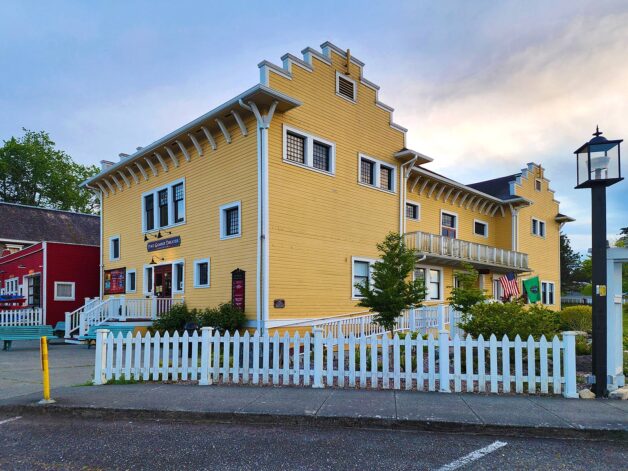 How does a nearly 120-year-old building become the center of a community, an arts center and a gathering place? Start with great architectural bones, a fascinating history and incredible financial support, and the result is the Port Gamble Theater.
How does a nearly 120-year-old building become the center of a community, an arts center and a gathering place? Start with great architectural bones, a fascinating history and incredible financial support, and the result is the Port Gamble Theater.
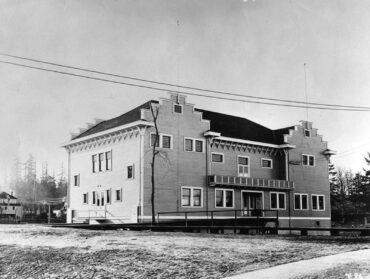 Let’s go back in time, way back to the days when the captains of Northwest industry were in lumber and when Northern Pacific Railroad steam engines puffed goods across the continent from Tacoma. The lumber mill, originally constructed in 1853 by Andrew Pope and William Talbot, brought a new industry to this sandy spot in Northern Kitsap on the Puget Sound. It was the perfect place for ships to dock, transporting old-growth timber to the fast-growing city of San Francisco and to Tacoma’s railroad terminus, sending this natural resource across the United States.
Let’s go back in time, way back to the days when the captains of Northwest industry were in lumber and when Northern Pacific Railroad steam engines puffed goods across the continent from Tacoma. The lumber mill, originally constructed in 1853 by Andrew Pope and William Talbot, brought a new industry to this sandy spot in Northern Kitsap on the Puget Sound. It was the perfect place for ships to dock, transporting old-growth timber to the fast-growing city of San Francisco and to Tacoma’s railroad terminus, sending this natural resource across the United States.
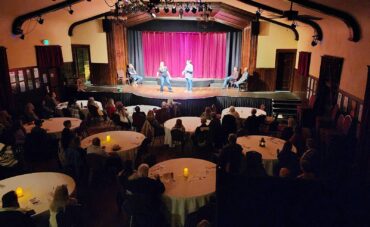 Port Gamble, named for Gamble Bay, grew into a thriving company town. Its architecture was modeled after the Eastern seaboard communities from which the mill workers hailed. By the late 1800s, the community had a drama club, a band, a church and fraternal organizations including the Masons and Odd Fellows.
Port Gamble, named for Gamble Bay, grew into a thriving company town. Its architecture was modeled after the Eastern seaboard communities from which the mill workers hailed. By the late 1800s, the community had a drama club, a band, a church and fraternal organizations including the Masons and Odd Fellows.
By 1906, community leaders wanted a theater for the dramatic society as well as a place for gatherings such as company dances and dinners. The town also needed a better place for its post office and mortuary. Hence, the prestigious Seattle architectural firm of Bebb and Mendel (think Samuel Hyde House, once home to the University of Washington president and former Russian consulate, or University Heights School) was commissioned to design such a building.
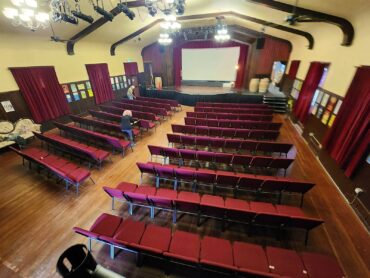 It cost $12,500 to build and upon completion, it boasted a vaudeville house and post office (which is still on the first floor, according to Port Gamble Town Manager Pete Orbea).
It cost $12,500 to build and upon completion, it boasted a vaudeville house and post office (which is still on the first floor, according to Port Gamble Town Manager Pete Orbea).
“The town’s mortuary was in the basement until 1929, and there was even a doctor and dentist in the building,” Orbea said.
As the company and town grew, so did the theater’s uses. Vaudeville impresario Alexander Pantages (Pantages Theatre in Tacoma) brought his acts to Port Gamble. When the films started taking over from vaudeville, projectors were installed for a full run of movies.
“In our town’s museum, there is a slide projector with hand-painted glass slides that show advertisements for what was going on at the theater,” said Brad Camp, the Port Gamble Theater board president and director.
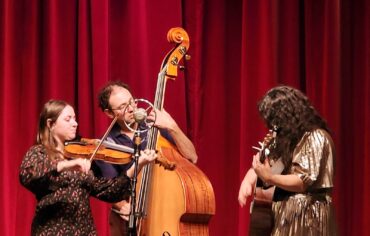 “When you go up to the projection room, or backstage, you find these really cool mementos of history,” Camp continued. “People left their names, their dates on the walls. There is even a note of a wedding that took place here.”
“When you go up to the projection room, or backstage, you find these really cool mementos of history,” Camp continued. “People left their names, their dates on the walls. There is even a note of a wedding that took place here.”
While the theater stopped showing films in 1956, the building continued to be fully used through the 1980s.
“The Boy Scouts and Girl Scouts held troop meetings here; there was a basketball hoop for community recreation; the company still hosted dinners and dances and the Odd Fellows met here. Of course, the Masons had their own building,” Camp explained.
Then the building fell into neglect and wasn’t used, except for the post office. A North Kitsap troupe, known as the Roving Players, was seeking a permanent home. In 2010, they produced “A Christmas Carol” in the theater to the fire department’s maximum audience size of 75. It was so successful that the group sat down with representatives of Pope Resources to discuss reopening the venue permanently. Such was the rebirth of the Port Gamble Theater.
 “When we came in, it was pretty dirty. The space was dark. There were candy wrappers and garbage left by kids under the stage,” said Camp, who, in addition to being the volunteer organization’s director, is a former professional photojournalist.
“When we came in, it was pretty dirty. The space was dark. There were candy wrappers and garbage left by kids under the stage,” said Camp, who, in addition to being the volunteer organization’s director, is a former professional photojournalist.
“I walked up across the catwalk between the ceiling and under the roof. It goes the entire length of the building. It was pretty unstable,” Orbea added.
Camp chimed in, “It’s OK now. There’s plywood on the catwalks. The original chairs are all stored up there and there’s cables running the length of the building for the theater lighting and films.”
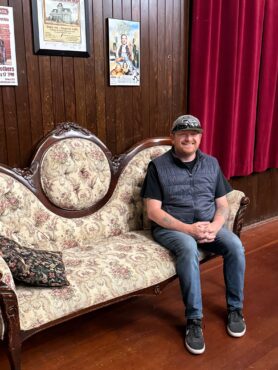
The first production the theater group put on was the iconic play “The Mousetrap” by Agatha Christie. Today, the theater group pulls its audiences from Port Angeles to Edmonds, to Port Orchard, to Sequim. Throughout the year, four productions are running three weekends each. Actors and directors, while not Equity, are highly trained and anxious to perform in the space.
“They really like the audiences, the community feel, the camaraderie,” Camp said. “We are a fun place to play in.”
While the men’s and women’s dressing rooms are small for large productions, they, too, are receptacles of history, with cast and crew members signing their names on the walls under the names of each production.
This year has been monumental for the theater. Not only has the theater group been producing its productions, but it has also been extraordinarily successful in fundraising.
“We began the effort about nine months ago,” Camp said. “Our first focus was for new chairs. We raised $12,000 in three days, with people giving what they could. Patrons just jumped in to buy the chairs.”
Then, an effort was launched for $15,000 for a new movie screen and an additional $30,000 for a projection system. “It was a lot of people, a couple angel donors, and wow, we did it,” Camp explained.
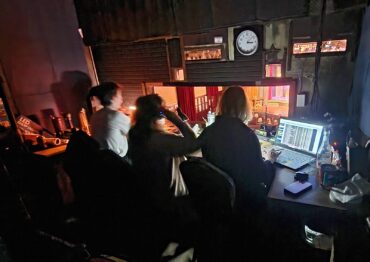 “Casablanca” (remember that famous line, “Play it again, Sam”?), first shown in the theater in 1942, was the first film shown this last May for the theater’s new vintage movie series. “We are going to focus on classic films and not compete with first-run cineplexes,” Camp said.
“Casablanca” (remember that famous line, “Play it again, Sam”?), first shown in the theater in 1942, was the first film shown this last May for the theater’s new vintage movie series. “We are going to focus on classic films and not compete with first-run cineplexes,” Camp said.
Ambitions for the theater are just beginning. In August, there was a theater camp for kids and teens. Camp can see the theater as an artistic anchor for the community and he’s more than enthusiastic.
“We can foresee festivals, music, even partnerships with film festivals like the Port Townsend Film Festival or Poulsbo Film Festival. One day, maybe we’d even have our own Port Gamble film festival and support Olympic Community College’s film school by showing films,” he said.
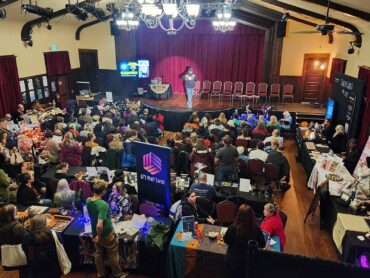 The small theater has a strong foundation to build upon. It has its own professional costumer and costume shop, prop room and storage, a 30-by-25-foot beautiful fir proscenium performance stage, good backstage crossover and soft legs that provide flexibility. Future goals include installing a sprung floor appropriate for dance, which will cost about $20,00, and a complete lighting upgrade that Camp estimates to cost about $80,000.
The small theater has a strong foundation to build upon. It has its own professional costumer and costume shop, prop room and storage, a 30-by-25-foot beautiful fir proscenium performance stage, good backstage crossover and soft legs that provide flexibility. Future goals include installing a sprung floor appropriate for dance, which will cost about $20,00, and a complete lighting upgrade that Camp estimates to cost about $80,000.
“It will give us the ability to program our lights by a tablet. I am also hoping to upgrade the audio in the fall to support cinema,” he said.
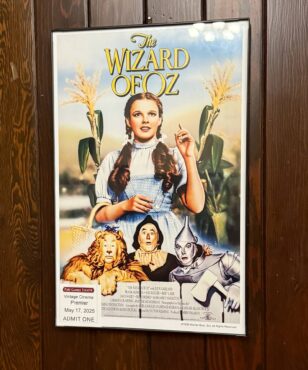 While live theater productions are matinees, catering to tourists, cinema presentations are at 7 in the evening. There are plenty of places to get nosh and drinks, with many establishments changing their menus seasonally. Popular places include Butcher & Baker Provisions, House 11 Tap Room and Bottle Shop, Daliah Cove Studio Tea Room and the Port Gamble General Store and Café. The theater opens early to purchase refreshments from its bar. Orbea said a new establishment, Whiskey and Waffles, will be opening on Labor Day weekend, featuring sweet and savory waffles, drinks and a coffee roaster.
While live theater productions are matinees, catering to tourists, cinema presentations are at 7 in the evening. There are plenty of places to get nosh and drinks, with many establishments changing their menus seasonally. Popular places include Butcher & Baker Provisions, House 11 Tap Room and Bottle Shop, Daliah Cove Studio Tea Room and the Port Gamble General Store and Café. The theater opens early to purchase refreshments from its bar. Orbea said a new establishment, Whiskey and Waffles, will be opening on Labor Day weekend, featuring sweet and savory waffles, drinks and a coffee roaster.
Still a company town, Port Gamble was purchased in 2020 by Rayonier, which owns the town and surrounding lands. There are big plans afoot to develop more housing and allow the National Historic Register town to become even more of a tourist attraction for Kitsap County.
Looking out over Puget Sound, the theater has one of the best views in the Northwest. Camp opened up the exterior French doors, stepped out onto the historic balcony above gardens and water, and sighed with a smile, “I have one of the best offices in the world, and it’s great to see this theater come back to life.”






























